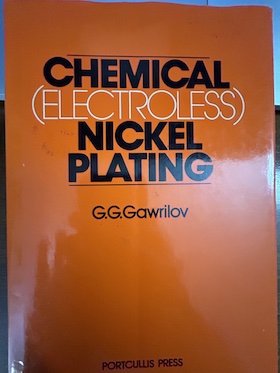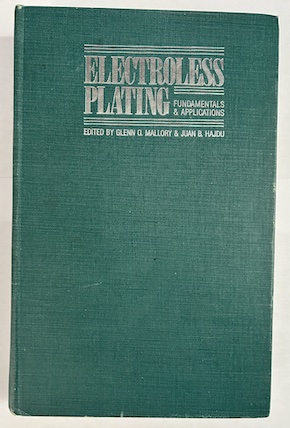
-----
Removing/Stripping Electroless Nickel Plating from Steel
Q. Hello everyone!
Good afternoon,
I have a question about Electroless Nickel Plating --
We have a process for electroless nickel plating; during the process we have some big problems on the product. We have a plan to remove the nickel layer then re-plate again.
Could you please share your experience how to remove the nickel layer? And what kind of chemical to use?
The thickness of plating 3-5 micron.
Thank you.
- Kota BATAM Indonesia
December 19, 2023
by G. G. Gawrilov

on eBay or Amazon
or AbeBooks
(affil link)
A. Hi Harpen.
Please tell us the substrate and (if you know it) the type of electroless nickel (boron, high phosphorous, etc.), but your plating is quite thin (<0.0002") and it should not be a big problem to remove it with a proprietary nickel stripper.
If you don't like that answer ...
In addition to the years of practical experience you can read about on this page, you can search the site for several other threads about stripping electroless nickel, or consult Mallory & Hajdu ⇨
which has a lot on the subject, most importantly the intro & cautions on page 106.
G.G. Gawrilov's "Chemical (Electroless) Nickel Plating" ⇨
looks like a good book to help you sort out what you may be doing wrong which is generating rejects, but it lacks an index so I'm not sure if it has any useful suggestions regarding stripping.
Unfortunately I don't have a copy of Wolfgang Riedel's "Electroless Nickel Plating" [on
eBay,
Amazon, &
AbeBooks affil links], or Fabienne Delaunois et al "Electroless Nickel Plating: Fundamentals to Applications" ⇦[this on
eBay,
Amazon, &
AbeBooks affil links] so I can't comment on whether they offer good coverage of stripping methods :-(
Luck & Regards,

Ted Mooney, P.E. RET
Striving to live Aloha
finishing.com - Pine Beach, New Jersey
Ted is available for instant help
or longer-term assistance.
⇩ Related postings, oldest first ⇩
Q. Are there chemical ways of removing electroless nickel plating from steel?
And are there chemical ways of removing tin plate from steel?
The criteria for either system - must not "poison" the surface nor cause loss of steel. And must be quick.
Is there a dye check that can be used after treatment that will show the complete removal of either plating?
Joe Redinger- Canada
1998
A. Cyanide-based strippers are pretty good at complexing other metals while leaving steel untouched.
adv. But if you need something cyanide-free, you might want to talk to a specialist in nickel strippers, like Metalx (Ronatec.us) [a finishing.com supporting advertiser].

Ted Mooney, P.E.
Striving to live Aloha
finishing.com - Pine Beach, New Jersey
Ted is available for instant help
or longer-term assistance.
A. Joe:
You might check with Enthone, they make a line of nickel & E nickel strippers. If I recall correctly it is called "N Strip".
Good Luck
- Putnam, Connecticut
Ed. note: Back in 1998, before automated spambots, most posters like Paul were known to us and we published brand & sourcing suggestions. Times changed and we'd drown under spam; for this and other reasons ( huh? why?) we can no longer post source or brand suggestions.
A. For high Phos EN, I like Metalx (Ronatec.us) [a finishing.com supporting advertiser] strippers. Work well and tend to be cheaper and less of a pain to dispose.
James Watts- Navarre, Florida
Ed. note: We can no longer post source or brand suggestions. But Metalx has been a supporting advertiser, helping make this forum possible, for decades. So please consider the continuing mention of Metalx B9 and B9+ on this page as paid advertisement.
![]() Please also see our FAQ on Stripping of Electroless Nickel.
Please also see our FAQ on Stripping of Electroless Nickel.
Regards,

Ted Mooney, P.E.
Striving to live Aloha
finishing.com - Pine Beach, New Jersey
Ted is available for instant help
or longer-term assistance.
A. In response to Mr. Redinger's question asking whether there's a dye to check if a steel part has been stripped of Nickel or other plating, I post this message for the curious. Generally in time you'll develop an "eye" for when a part is stripped. However if you simply immerse the part in [sulfuric] acid-copper plating bath (without current) the copper will contact plate to the steel through galvanic action and you'll be able to see any non-stripped areas. You can remove the immersion copper film quickly (a matter of seconds) by swishing the part in your strip bath. Regards,
Steve Wilcox- Tecumseh, Michigan
2000
Multiple threads merged: please forgive chronology errors and repetition 🙂
Q. I am trying to remove electroless Nickel coating and Copper strike from steel without corroding the steel surface. So far my results are very inconsistent: parts cleaned in the same acid vat never look the same. My acid bath is basically Hydrochloric/Sulfuric acids at 1 to 3 ratio with some surfactants and wetting agents. What am I missing in this process?
Thank you in advance,
Nina
Memphis, Tennessee
1999
A. There are a number of commercial strippers for electroless nickel and copper. Both immersion strippers and electrolytic strippers will remove the coating without significantly etching the substrate. My favorite is ammonium nitrate based solutions which operate at a pH of about 6 and are quite fast, especially for EN.
Carl SteineckerWaterbury, Connecticut
A. Best way to remove plating is let the platers do it. We have to de-plate and re-plate more often then we wish to remember. We send it back to the platers. They in turn use proprietary mixes to selectively attack the plating while leaving the base metal alone. Reverse plating is also another option. Proprietary plating removers are mixtures of acids, highly buffered, with selective chemicals to focus the acids on the platings and leave the parent materials alone. More than that, I cannot help, except to point you to some references. I remember several that covered stripping, but it was not my focus and I took no notes:
1. The Canning Handbook [on eBay, Amazon, AbeBooks affil links]
2. Electroplating, 1978 ⇦[this on eBay , Amazon, AbeBooks affil links] ; American Society of Electroplaters McGraw-Hill Book Co, NY ISBN 0-07-038836-0
3. Electroplating Engineering Handbook ⇦ this on eBay, AbeBooks, or Amazon [affil link] , 4th Edition 1984: L.D. Durney.
4. Electrodeposition of Alloys, Vol 1 (Principles and Practice) ⇦[this on Amazon, eBay, & AbeBooks affil links] 1963: A. Brenner Academic Press, NY CCN 62-13044
5. The modern electroplating laboratory manual ⇦[this on Amazon or AbeBooks affil links] 1965: I.C. Armet Robert Draper Ltd, Teddington, England No I.D.
University Libraries are godsends of good data. Good luck.
Lee R. Williamstransducers - Costa Mesa, California
A. Dear Sir,
For Stripping electroless nickel from mild steel substrate you can try with mixture comprising 7 parts of nitric acid and 3 parts of acetic acid with /without additives. Care should be taken to check the basis metal often during the stripping process to avoid etching of basis metal.
With regards,
- Bangalore, Karnataka, India
2005
Q. Do you have any suggestions for stripping electroless nickel from a 4340 steel component heat treated to a Rockwell C 50-54 hardness. The nickel plating was applied per MIL-C-26074 [⇦ this spec on DLA], class 2 grade B at .0005 to .0007 thickness.
Sam PoutousCentral Point, Oregon
2002
A. Several proprietary products exist [ed. note: already mentioned on this page] which are used according to the bulletins. Another very easy and quick way to strip nickel is using 100% nitric acid with 10% of acetic acid as inhibitor. The pieces should be baked to eliminate any trace of humidity; to submerge them in the solution without movement, neither to take it out it until it is stripped. Note, the pieces should be hung.
Gabriel Ramirez Nuñezplating - Toluca, Mexico
2004
A. Hi, Sam. Metalx (Ronatec.us) [a finishing.com supporting advertiser] offers their B-9 series of strippers for this purpose. Good luck.
Regards,

Ted Mooney, P.E.
Striving to live Aloha
finishing.com - Pine Beach, New Jersey
Ted is available for instant help
or longer-term assistance.
Q. I have successfully plated old motorcycle parts with electroless nickel in the past, however my latest attempt is a failure and I believe it is due to one component still having zinc attached which I was not aware of. The result is that the nuts and bolts that I was plating have come out dull grey.
How can I remove this dull grey layer and successfully nickel plate these parts?
Motorcycle restorer - Slacks Creek, Qld, Australia
April 4, 2011
A. Hi Brian,
EN is a bear to remove chemically. You didn't say what the base metal is or what kind of EN (high phos is harder to strip) and an answer pretty much depends on that. If it is steel I would blast it.

Trent Kaufman
electroplater - Galva, Illinois
Q. Hi Trent, Thank you for your response.
I am told by the supplier that the nickel is not high phos, but S nickel rounds. The parts are mainly nuts and bolts with a few small brackets. Sorry, I have no idea what steel they would be. I think they would all be too small to blast.
Since I posted my question to you I have mentioned my problem to others and one suggested I plate over what I already have. I have not tried that as I did not want to ruin the new chemical I have left. What are your thoughts on that suggestion?
Thanks again for your time.
Brian
- Queensland, Australia
A. S Nickel Rounds are an anode material, so that indicates that your vendor electroplated nickel rather than electroless nickel. One relatively safe chemical option for stripping would be MetalX B-9+ Metalx (Ronatec.us) [a finishing.com supporting advertiser]. Overplating is possible, but passive nickel is difficult to chemically activate and would require hazardous chemicals, so I'd hesitate to recommend that you proceed in that direction.

Jon Barrows, MSF, EHSSC
Kansas City
![]() Thank you for your reply Jon. The supplier acknowledges he gave me wrong info. The product is not S rounds but the nickel is at 14% (whatever that means). I strongly suspect there is a problem with the nickel supplied as I purchased a new batch. I split this in half and mixed according to supplier instructions. After a proper cleaning and rinsing and using different stainless containers to plate I got the same poor result. The supplier is investigating my suggestion of problem nickel, but as yet no answer.
Thank you for your reply Jon. The supplier acknowledges he gave me wrong info. The product is not S rounds but the nickel is at 14% (whatever that means). I strongly suspect there is a problem with the nickel supplied as I purchased a new batch. I split this in half and mixed according to supplier instructions. After a proper cleaning and rinsing and using different stainless containers to plate I got the same poor result. The supplier is investigating my suggestion of problem nickel, but as yet no answer.
I have ordered some Metalx stripper and a different electroless kit from a new supplier and will give that a go. Hopefully it will solve my problem.
Thank you again for your interest.
Cheers, Brian
- Slacks Creek Qld Australia
Ed. note: Brian, we still don't know whether you are doing electroplating (when you talk about anodes), or electroless plating (when you say that's what you're doing). Please take the time to tell us what you are buying and what you are doing.
But in either case something is quite wrong there; you can't electroplate in a stainless steel tank, and you can't electrolessly plate unless you have a special system to keep the electroless nickel from depositing on the stainless steel and triggering a plate-out and collapse of the solution.
A. One of our standard operations was stripping and replating of worn down parts and tools.
Stripping can be a fairly simple and cost effect operation with the use of B9, tap water, a plastic tank big enough to completely submerge the parts, a titanium (for extended use) fish tank heater and low air or fish pump to agitate the solution.
Process: 1 to 7 days depending on thickness of nickel plating on parts. Mix B9 into water, bring up to 120 to 150f, agitate solution (very low movement of solution needed) and wait checking parts daily. Nickel will turn black and come right off.
Prep of parts recommended by sand blasting to remove any dirt or other material which may cover nickel. Also blasting all parts when removed from B9 bath.
Hope this helps. I personally have stripped thousands of parts this way. On a side note it says B9 is safe with copper this is true but eventually copper will start to pit and break if left uncovered in solution for long periods of time
- Novi, Michigan
May 21, 2023
Multiple threads merged: please forgive chronology errors and repetition 🙂
Q. I am running an electroless nickel company in Argentina. I have a lot of problems to strip the MP electroless nickel from steel, especially I have trouble with nitrided steel or hardened steel. I would very appreciate if someone can give the composition of a stripping bath for steel. Thanks very much. P.S.:actually I'm using a cyanide solution to strip from steel, but it's too slow (really slow)
Schonwald Emmanuel- Buenos Aires, Argentina
2000
A. Hola Emmanuel, We strip ENi from Steel (h13) with proprietary products from our suppliers. They are expensive products, but work fast. Best regards,
Carlos Cielakplating shop - Mexico City, DF, Mexico
Q. Sir, I want to remove electroless nickel plating on mild steel; so what is the procedure?
Vikrant Sammanwar- Pune, Maharashtra, India
October 29, 2013
A. Hi Vikrant. It looks like that question has been addressed repeatedly on this page. Please try your best to frame your question in terms of one of the answers already provided so that we can appreciate what you are having difficulty understanding, or what we may be misunderstanding about your situation. Thanks!
Regards,

Ted Mooney, P.E.
Striving to live Aloha
finishing.com - Pine Beach, New Jersey
Ted is available for instant help
or longer-term assistance.
Q. Sir,
We are doing High Phosphorus Electroless Nickel Plating for the valve industry about 100 Microns.
Removing the plating is very difficult.
Can you please give the right and fast method.
With regards,
- Coimbatore, Tamilnadu, India
June 2, 2015
A. Hi Sakthivel. Please tell us what process you are using which is too slow, or why you feel that the previously proposed solutions are wrong. Thanks!
Your posting hasn't received any response -- readers may be reluctant to post suggestions, figuring you would say "that's what we're doing, and it's too slow" :-)
Regards,

Ted Mooney, P.E. RET
Striving to live Aloha
finishing.com - Pine Beach, New Jersey
Ted is available for instant help
or longer-term assistance.
Q, A, or Comment on THIS thread -or- Start a NEW Thread

